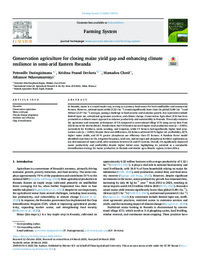Conservation agriculture for closing maize yield gap and enhancing climate resilience in semi-arid Eastern Rwanda

Authors:
In Rwanda, maize is a crucial staple crop, serving as a primary food source for both smallholder and commercial farmers. However, national maize yields (1.52 t ha−1) remain significantly lower than the global (5.88 t ha−1) and African (2.27 t ha−1) averages, posing a challenge to food security and economic growth. Key constraints include limited input use, suboptimal agronomic practices, and climate change. Conservation Agriculture (CA) has been promoted as a climate-smart approach to enhance productivity and sustainability in Rwanda. This study evaluates the agronomic and economic performance of CA compared to conventional tillage (CT) using survey data from 222 farms in the Kirehe district. Results show that CA farmers incurred higher total production costs (p < 0.001), particularly for fertilizers, seeds, weeding, and irrigation, while CT farmers had significantly higher land preparation costs (p < 0.001). Despite these cost differences, CA farmers achieved 40 % higher net profitability, 20 % higher maize yields, and 10 % greater phosphorus use efficiency than CT farmers. A Random Forest model identified experience in CA, irrigation frequency, seed rate, and nitrogen and phosphorus fertilizer application as key determinants of maize yield, with variations between CA and CT systems. Overall, CA significantly improved maize productivity and profitability despite higher initial costs, highlighting its potential as a sustainable intensification strategy for maize production in Rwanda and similar agro-climatic regions in East Africa.
